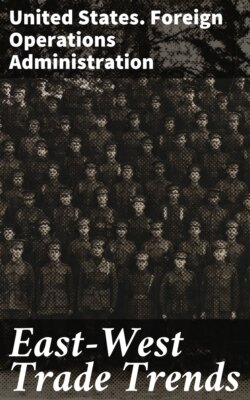Читать книгу East-West Trade Trends - United States. Foreign Operations Administration - Страница 6
How Forced Industrialization Affects Trade
ОглавлениеMoscow laid the same pattern upon the European satellite countries and cut them to fit the pattern. Heavy industrialization was imposed on them regardless of their desires and the needs of the people. This forced industrialization absorbed large amounts of commodities that were formerly available for export to the free world. At the same time the collectivization of agriculture was imposed on the satellites, and this aggravated the difficulties of keeping pace in farm output.
While these policies were reducing the total amounts of goods the satellites had available for export to the West, the U.S.S.R. was siphoning off great trainloads of what remained. The ability of these countries to trade with the West was further reduced as they were pushed into granting priorities to one another on the exchange of items they could have more profitably sold to the free world.
Moscow also forced upon the satellites the characteristic Soviet trading goal of reducing and eventually eliminating all dependence on the free world. Lenin himself had emphasized that the first goal of the Soviet Union in its economic relations with the outside world was to gain “economic independence from the capitalist countries.” A prominent Soviet economist, Mishustin, in a book published in 1941, spelled out this principle in greater detail:
The main goal of the Soviet import (policy) is to utilize foreign products, and above all, foreign machinery ... for the technical and economic independence of the U.S.S.R.... The import (policy) of the U.S.S.R. is so organized that it aids the speediest liberation from the need to import.
In 1946 the leading Soviet economist, Vosnosensky, restated the objective in the Government periodical, Planned Economy:
The U.S.S.R. will continue in the future to maintain economic ties with foreign countries in accordance with the tested line of the Soviet government directed towards the attainment of the technical-economic independence of the Soviet Union.
The Kremlin’s new Eastern European empire included vast natural resources and sizeable labor reserves. Nevertheless it was—and still is—a long way from being self-sufficient, in the sense of being able to match the production levels of the free world, or even in the sense of fulfilling its own ambitious production plans, without trade with the West. Imposing an ultimate goal of self-sufficiency thus could not eliminate the Soviet bloc’s dependence on the free world. Communist trade planners still found it advantageous to import from the free world many things the bloc countries needed. The new goal did, however, affect the composition of the satellites’ trade. The planners placed much greater emphasis on the importation of industrial raw materials and equipment that would, in the long run, reduce the need to import.
In the U.S.S.R. itself, the Government had always been disinclined to offer exports in order to import consumer goods, like meat, butter, textiles, and appliances. Now the same policy was clamped on the satellites. So the bulk of Soviet-bloc imports from the West consisted of goods that did not enter the homes of the people.
The result of all this was a big decline in trade between Western and Eastern Europe, as compared with prewar years. Before the war, countries which now make up the Soviet bloc in Europe carried on less than 10 percent of their foreign trade with one another; now this has risen to more than 75 percent.
